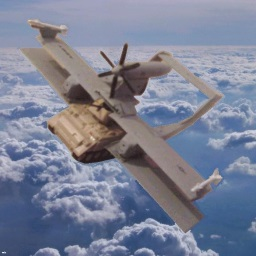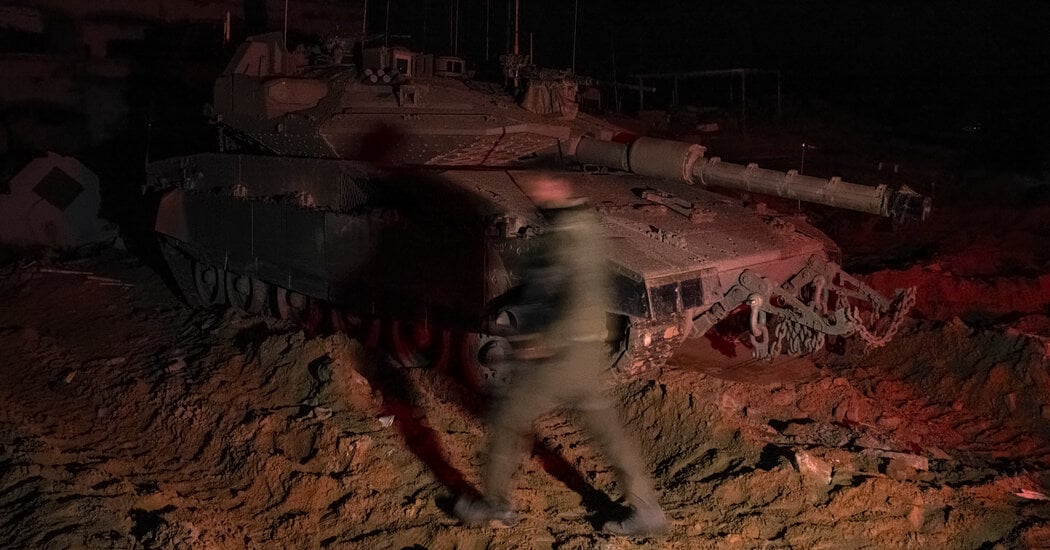Since the terrorist attacks on Oct. 7, Israel has recovered a trove of intelligence that its military has used to assess the extent of Hamas’s plans, as well as its battle tactics and abilities, information that Israeli officials say has helped shape the war in Gaza.
At the sites of attacks in Israel and battles in Gaza, the military has found items that detail the location of Hamas installations and tunnels, including how the armed group operates underground, according to documents and other information made available by the Israeli military for The New York Times to review. It also retrieved a laptop that appeared to show that Hamas wanted to seize a number of previously unknown areas on Oct. 7, including a military base south of Tel Aviv.
“This war, we are witnessing something we haven’t seen in previous wars: ground forces, including the armored corps, benefiting from the real-time, precise intelligence information directly transmitted to them,” said Brig. Gen. Hisham Ibrahim, the commander of the armored corps. “Information from intelligence units is swiftly transmitted to combat forces.”
The Israeli Army launched a devastating counterattack after Hamas-led assailants killed about 1,200 people and took approximately 240 hostages, according to the Israeli authorities. In an effort to eliminate Hamas, the military has bombarded and invaded the enclave, in a war that has killed more than 15,000 Gazans, according to the health authorities in Gaza.
At a briefing on Monday for journalists at a military base north of Tel Aviv, the Israeli military shared some of the materials collected over the course of the war from dead fighters and areas inside the Gaza Strip, which it says collectively includes maps, pamphlets, transmitters, phones, video cameras, walkie-talkies, notebooks and computers. The information is being analyzed by a new Israeli unit responsible for making sure the findings quickly get to the soldiers battling Hamas, officials said. Image Israeli soldiers during a ground operation in the Gaza Strip last month. The military has bombarded and invaded the enclave in what it says is an effort to eliminate Hamas.Credit…Victor R. Caivano/Associated Press
The military provided access to key intelligence documents on the agreement that reporters would not disclose granular details while making some of the information available for publication. The journalists had to use surgical gloves to handle materials, some of which were stained with dried blood.
Materials reviewed by The Times were consistent with other known documents and gear found in the aftermath of the Oct. 7 attacks, information made public by the Israeli military and found in Hamas videos. The Times has also reviewed photographs of dead Hamas members and their personal belongings with some of the same items shared by the military at the briefing.
Some of the documents described extensive information about Hamas tactics and military formations. One document viewed by The Times included the breakdown of a platoon, including the ages of the fighters in it; more than half were older than 25, indicating that this particular platoon was filled with seasoned members.
The military has also collected photographs and videos of Hamas military leaders, information that could be used for targeting purposes. On Tuesday, the Israeli military released a picture of what it said were senior Hamas military leaders in northern Gaza enjoying food inside a tunnel, claiming that five of the men had been killed. The military said an Israeli intelligence unit had analyzed the picture after it was seized in Gaza in a tunnel near the Indonesian Hospital.
The military wing of Hamas, Al Qassam Brigades, had previously confirmed that at least three of men in the picture had been killed.
In addition, the Israeli military said it had retrieved journals that Hamas assailants had been carrying, along with other personal items.
Relying on such information, General Ibrahim said he had made “small adjustments to the fighting strategy” since the war started. Image A drone and weapons that the Israeli military claimed were found on the grounds of Al-Shifa Hospital in Gaza. Israel has been under intense international scrutiny to justify incursions into hospitals.Credit…Daniel Berehulak/The New York Times
From a makeshift military camp in southern Israel, General Ibrahim, the commander of the armored corps, oversees aspects of tank warfare, which is taking place in a densely populated area. The 46-year-old general is one of the highest-ranking officers from Israel’s Druse community, an Arabic-speaking religious minority.
Since the cease-fire ended last week, Israeli soldiers have been engaged in heavy fighting in southern Gaza near the city of Khan Younis, as well as the northern residential neighborhoods of Jabaliya and Shuja’iyya. Israeli tanks have played a key role in the battles. More than a dozen Israeli soldiers have been killed since the fighting has resumed.
He is intensely focused on protecting soldiers and tanks, and outwitting Hamas. General Ibrahim said he has six small teams on the ground in Gaza to gain insights from different units, the type of materials shared with The Times. He said “learning bulletins” are sent out to forces every few days.
He says he has also gleaned lessons from Russia’s war in Ukraine, particularly how Russian tanks in Ukraine at times became easy targets. To adapt to the threat of Hamas drones, he said that Israel rushed to make sure that tanks were outfitted with canopies over turrets.
Known as “pergolas,” General Ibrahim said they had already proved to be effective deterrents, explaining that Hamas drones appear to avoid tanks with the canopies since they provide protection against warheads. The general described the pergola as a low-tech measure used to defend against drones, while adding that the military has high-tech advantages, including a defense system known as “Trophy.”
The materials highlight other challenges for General Ibrahim and his team. Hamas booklets, viewed by The Times, show the weak spots of Israel’s Merkava tanks operating inside the Gaza Strip, with their huge 120-millimeter cannons, as well as Israeli armored personnel carriers. Hamas fighters also have instructions on which type of warhead to use against Israel armor. He said the Hamas fighters have mostly relied on rocket-propelled grenade launchers in attacks on armor. Image An Israeli tank near the border with Gaza last month. Tanks have played a key role in the battles since the cease-fire.Credit…Tamir Kalifa for The New York Times
Hamas fighters, the general said, will regroup after suffering bad losses and return to fight in destroyed areas — seemingly lost ground. The military has adapted to avoid Hamas improvised explosive devices. Similar devices were used to deadly effect in Iraq by militias against U.S. forces.
Whether it is recovering hostages or targeting senior Hamas leaders in the vast tunnel network under Gaza, acting quickly on new intelligence recovered from the battlefield is essential for a successful mission, current and former American military and intelligence officials said.
“Going after hostages or leadership targets are very intelligence-driven events,” said Mick Mulroy, a retired C.I.A. officer and a former top Middle East policy official at the Pentagon. Ideally, Mr. Mulroy said, highly trained special operations units are embedded with conventional forces conducting ground operations or on alert nearby to respond quickly to such time-sensitive information.
As Israeli ground forces clear areas of southern Gaza, Mr. Mulroy said soldiers would most likely use encrypted messaging apps to alert one another to new tactics, techniques or procedures Hamas is using.
“Lessons learned can be disseminated very quickly,” he said.
General Ibrahim has said that the Israeli military has relied heavily on what is known as combined arms fighting: the use of tanks, infantry and combat engineering under the cover of heavy airstrikes.
“It’s a force multiplier, and has been very effective in Gaza,” he said. Image A shaft on the grounds of Al-Shifa Hospital last month. Israel has accused Hamas of using the complex to hide weapons and command centers, a claim Hamas and hospital officials deny.Credit…Daniel Berehulak/The New York Times
While Israeli strategy has helped keep the army’s casualties down, thousands of civilians in Gaza have been killed. The rising death toll has intensified international pressure to negotiate another cease-fire.
The American government has also asked the Israelis to fight more surgically as they drive deeper in southern Gaza in places like Khan Younis. While the Israeli military believes that is where parts of Hamas leadership are thought to be hiding, it is also packed with civilians, many of them displaced several times already with few places to go and confusion about what is safe.
Asked about staggering numbers of civilian deaths, General Ibrahim defended the Israeli military. He said that Israel had tried to clear the battlefield of civilians, giving them time to leave, dropping fliers, broadcasting on speakers and calling their cellphones to leave the area.
“It’s almost impossible to have no civilian casualties in a military operation like this,” Mr. Mulroy said. “Their objective is to degrade Hamas’s military capability to the point where it doesn’t pose an immediate threat to Israel.”
The United States has designated Hamas a terrorist organization, and American officials have encouraged the Israelis to model their ground campaign on an approach employed by Stanley A. McChrystal when he commanded U.S. Special Operations forces in a targeted-killing campaign against Al Qaeda in Iraq. Image Mourning those killed in Khan Younis, in southern Gaza. Gazans have been fleeing fighting there, but refuge is increasingly hard to find.Credit…Yousef Masoud for The New York Times
That campaign, which killed the group’s leader in 2006, demonstrated to U.S. military theorists that the use of small teams of commandos, combined with precision strikes from drones and manned aircraft and acting quickly on new information about the enemy seized on the battlefield, can be effective at flushing out and targeting key leaders, and weakening their organizations.
General Ibrahim said that the fighting — both above and below ground — would be tough in southern Gaza but that “we will still win.” He added, “We are fighting Hamas, not the people of Gaza.” Israeli security officials are continuing to try to piece together where Hamas obtained some of its equipment and sensitive details about Israeli locations. Among the items found in Israel after the attacks and displayed were Motorola radios used in Hamas vehicles to maintain contact with commanders in Gaza. The radios were similar to the ones used in Israeli taxis.
There were also detailed maps of at least one kibbutz with seemingly every building marked.
And on the computer taken from a Hamas commander’s truck was also a schematic of the military base south of Tel Aviv, showing many of the buildings. It is not clear how much of the detailed map of the base was available publicly.
Gal Koplewitz contributed reporting from Jerusalem, and Eric Schmitt from Washington.
Adam Goldman writes about the F.B.I. and national security. He has been a journalist for more than two decades. More about Adam Goldman
They’re using them to counter small munitions dropped from drones, Russia tried using them to counter javelins. These things might be somewhat effective to counter small stuff in an urban environment while being utterly useless against something a bit more sophisticated.
The click bait title was just an interesting detail in a long & informative article that I assumed people interested in the military would enjoy. But thanks for the well Ackchyually…
🤓
I think it’s interesting that the IDF looks at the emerging battle tactics in Ukraine and decides to copy the Russians.
Hamas doesn’t have Javelins like Ukraine does so slat armor is actually effective in this situation.


